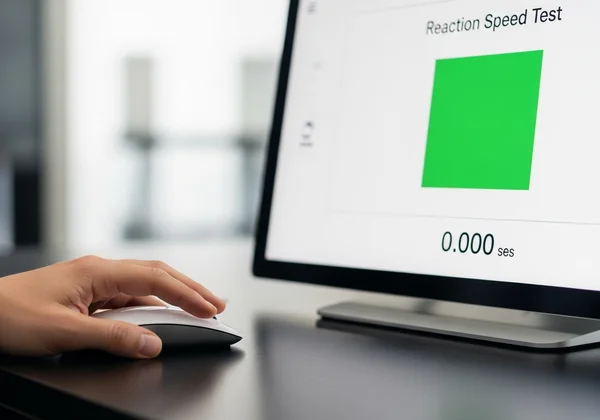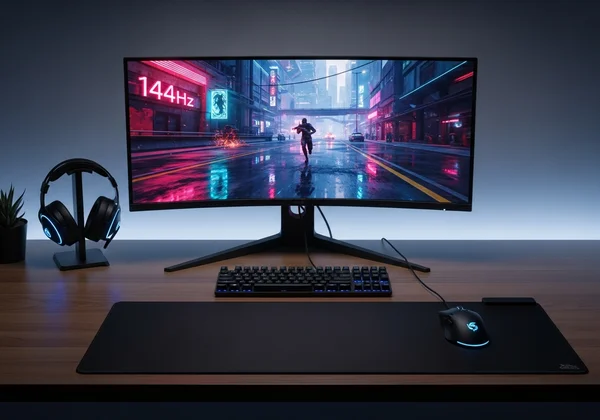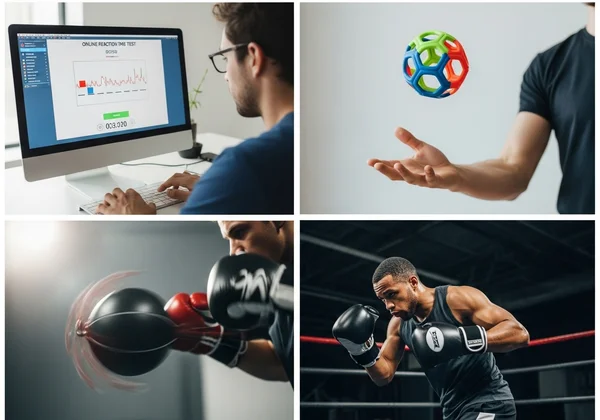Reaction Speed Test & Training Guide: Improve Your Reflexes Fast
Are you looking to sharpen your reflexes, gain an edge in gaming, or simply boost your cognitive speed in daily life? If you've ever asked yourself how to get faster reflexes, you've come to the right place. This ultimate guide will break down the science behind reaction time and provide a science-backed framework to help you improve your reaction time. Your journey starts with understanding where you stand, and you can begin by taking our free online test.

The Science Behind Your Lightning-Fast Reflexes
Before you can improve your reflexes, it helps to understand what’s happening under the hood. Reaction time isn't just about fast fingers; it's a complex neurological process. Every millisecond counts, from the moment your eyes see a stimulus to the instant your muscles respond.
Simple Reaction vs. Choice Reaction Time: Why the Distinction Matters
Not all reactions are created equal. A simple reaction time involves responding to a single, expected stimulus, like clicking when a light turns green. This is exactly what our tool measures. Choice reaction time is more complex, requiring you to make a decision before acting, such as pressing a specific key based on which of several lights illuminates. While both are important, mastering your simple reaction time provides the fundamental speed that underpins more complex cognitive tasks.
The Neurological Pathway: From Stimulus to Action
When you see a signal, your brain embarks on a high-speed journey. The visual cue travels from your eyes to your brain's occipital lobe. Your brain then processes this information and sends a command down your spinal cord to the muscles in your hand and fingers, instructing them to click. This entire neurological pathway happens in a fraction of a second. Understanding this process highlights that improvement comes from making this pathway more efficient through focused practice with a reaction speed test.

Key Factors Influencing Your Reaction Speed Guide
Your reaction time isn't a fixed number; it fluctuates based on numerous internal and external factors. By identifying and optimizing these variables, you can unlock significant gains in your performance.
Fueling Your Reflexes Naturally: Sleep, Diet, and Hydration
Your body is a high-performance machine, and it needs the right fuel. Sleep deprivation is a major culprit for slow reactions, as it impairs cognitive function. A balanced diet rich in antioxidants and omega-3 fatty acids supports brain health, while proper hydration ensures your neural signals fire optimally. Never underestimate the power of a good night's sleep and a glass of water.
The Impact of Age, Stress, and Fatigue on Your Slow Reaction Time
It's natural for reaction time to slow with age, but this decline can be managed. Stress and mental fatigue are also significant inhibitors, flooding your system with cortisol and making it difficult to focus. Regular mindfulness, breaks from screens, and physical activity can combat these effects, keeping your mind sharp and your reflexes ready for action. If you're worried your score is slow, check your results against the average.
Equipment & Environment: Minimizing Latency (Especially for Gamers)
For competitive gamers, every millisecond is the difference between victory and defeat. Your equipment matters. A high-refresh-rate monitor (144Hz or higher) and a gaming mouse with a high polling rate can significantly reduce input lag. Ensuring a distraction-free environment allows your brain to dedicate all its resources to the task at hand, whether you're gaming or taking a click test.

Proven Reaction Time Training Methods & Drills
Understanding the science is one thing; putting it into practice is another. Consistent, targeted training is the most effective way to shorten your response time. Here are proven methods to integrate into your routine.
Digital Drills & Online Trainers: Using Tools Like Ours
The most direct way to improve your reaction time is to practice the skill itself. Using an online tool provides instant feedback and allows you to track your improvement over time. Make it a habit to complete a few rounds daily. The goal is to build muscle memory and make the neural pathway from stimulus to response as efficient as possible. Start your training on our platform today.
Sensory Training: Sharpening Visual, Auditory, and Tactile Reflexes
While our test focuses on visual cues, your reflexes operate across all senses. You can train them in various ways. Try exercises that require you to respond to sound cues, or practice catching a dropped object. The more you challenge your brain to process different types of sensory information quickly, the faster your overall reaction capabilities will become.
Sports-Specific & Real-World Reflex Exercises
For athletes, translating raw reaction speed into sport-specific skills is crucial. Boxers use speed bags, tennis players practice volley drills, and goalkeepers use reaction balls. These exercises train not just a simple response but a complex, full-body reaction. Even simple activities like playing catch or juggling can have a significant impact on your hand-eye coordination and reflex speed.

Building Your Personalized Reaction Time Improvement Plan
A scattered approach yields scattered results. To truly improve, you need a structured plan that is tailored to your goals and lifestyle.
Setting Realistic Goals and Tracking Progress with Data
What gets measured gets managed. Start by establishing your baseline score using a reliable reaction time game. Set a realistic improvement goal, such as shaving 10-15ms off your average score over a month. Regularly testing yourself allows you to see what training methods are working and keeps you motivated on your journey to faster reflexes.
Consistency is Key: Integrating Training into Your Daily Routine
You don't need to spend hours a day training. Just five minutes of focused practice daily is more effective than one long session per week. Integrate it into your routine—perhaps as a warm-up before a gaming session or as a quick mental break during work. Consistency reinforces the neural pathways, making your quick responses second nature.
Your Journey to Faster Reflexes Starts Now: Take the Test!
Improving your reaction time is an achievable goal that offers benefits in gaming, sports, and everyday safety. It requires understanding the science, optimizing your lifestyle, and committing to consistent training. The most crucial step is the first one: knowing your starting point. Now that you have the knowledge and the roadmap, it's time to put it into action. Visit our homepage to take the test, track your score, and begin your journey to lightning-fast reflexes.
Frequently Asked Questions About Improving Reaction Time
What is considered a good reaction time?
While the average reaction time for humans is around 200-250 milliseconds (ms), "good" is relative. Elite gamers and athletes often score below 150ms. Factors like age, alertness, and even the device you're using can affect your score. The best way to know where you stand is to discover your speed and track your personal improvement.
How can I specifically improve my reaction time for gaming?
For gamers, improvement is twofold. First, optimize your hardware by using a high-refresh-rate monitor and a low-latency mouse. Second, practice consistently with aim trainers and reaction time tools. This builds the specific muscle memory needed for in-game actions like flick shots and split-second decisions.
What commonly causes a slow reaction time?
The most common culprits for a temporarily slow reaction time are fatigue, dehydration, stress, and lack of sleep. Distractions in your environment also play a huge role. Long-term factors can include age and certain health conditions, but lifestyle choices often have the most immediate and significant impact.
Is reaction time primarily genetic, or can it be significantly improved?
Genetics may set a certain baseline or ceiling for your potential, but your trainable range is vast. Through consistent practice, lifestyle optimization, and focused drills, nearly everyone can achieve significant improvements in their reaction speed. Think of it like sprinting: some people are born with a natural advantage, but everyone can run faster with dedicated training.